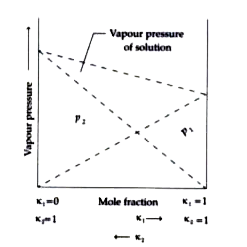State Raoult.s law. How is the molecular mass of a solute determined from lowering of vapour pressure measurement ?
Raoult.s Law The French Chemist, Francois Marte Raoult gave a quantitative relationship between the partial pressures and the mole fractions of two components. This relationship is known as Raoult.s law, which states that, "At a given temperature, for a solution of each component of the solution is directly proportional to its mole fraction present in solution".
Let two volatile liquids 1 and 2 have mole fractions as and , respectively. If and are vapour pressures of these components in the solution, then according to Raoult.s law
For component 1, and
Similarly, for component 2,
where, is the vapour pressure of pure component 1 and is the vapour pressure of pure component 2 at same temperature.
Determination of Molecular Mass of Solute Let is the mole fraction of solvent, is that of solute, is the vapour pressure of pure solvent and p is that of solution.
According to Raoult.s law, or
Since, is always less than 1, so vapour pressure of the solution will always be less than the vapour pressure of pure solvent .
So, lowering in vapour pressure of solvent is
But, or
So, or
So, relative lowering in vapour pressure of an ideal solution containing the non-volatile solute is equal to the mole fraction of the solute at a given temperature.
Let, are the masses and and are the molar masses of the solvent and solute, respectively. If moles of solute be dissolved in moles of the solvent, then the mole fraction if the solute
For very dilute solutions,
So, or
Similar Questions
Knowledge Check
- Question 1 - Select One
According to Raoult's law the relative lowering of vapour pressure for a solution is equal to
AMole fraction of soluteBMole fraction of solventCMoles of soluteDMoles of solvent - Question 2 - Select One
Read the passage given below and answer the following questions :
Raoult's law states that for a solution of volatile liquids, the partial vapour pressure of each component of the solution is directly proportional to its mole fraction present in solution. Dalton's law of partial pressure states that the total pressure Ptotal over the solution phase in the container will be the sum of the partial pressures of the components of the solution and is given as:
Ptotal= P1+ P2

What type of deviation from Raoult's law does the above graph represent ?AFirst positive then negativeBNegative deviationCPositive deviationDFirst negative then positive - Question 3 - Select One
According to Raoult's law the relative lowering of vapour pressure for a solution is equal to
AMole fraction of the solventBMole fraction of the soluteCWeight percentage of a soluteDWeight percentage of solvent
State Raoult's law. Why is the vapour pressure of a solvent lowered by the addition of nonvolatile solute to it? A solution containing 18 g of non-volatile solute in 200 g of water freezes at 272.07 K. Calculate the molecular mass of the solute. (Given Kf = 1.86 K/m).
View SolutionAccording to Raoult's law the relative lowering of vapour pressure for a solution is equal to
View SolutionState Raoult's law. Explain from it why the vapour pressure of a solution is always less than that of a pure solvent.
View SolutionUsing Raoult's law explain how the total vapour pressure over the solution is related to mole fraction of components in the following solutions.
(ii) NaCl(s)andH2O(l)View SolutionWhich of the following is the expression of Raoult’s law? (po = vapour pressure of pure solvent, ps = vapour pressure of the solution)
View Solution

